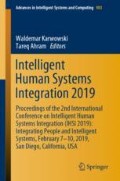Abstract
This paper presents a preliminary work of a simulation study for the evaluation of human-machine team (HMT) performance with assistance of a sentinel system under cyberattacks. Sentinel system is an intelligent agent of cyberattack-detection kit, whose user interface (UI) was designed and implemented as a proof-of-concept in the simulation. The goal for this sentinel system is to improve the pilots’ Situation Awareness (SA) of the system vulnerability and resiliency, such that the HMT performance can be improved against disruptive events. Based on the literature of cyberattacks on unmanned aerial vehicle (UAV) control systems, realistic mission operation and cyberattack scenarios were identified and implemented on a simulated UAV ground control station (GCS). In the follow-up experiment, up to twenty-four Air Force pilots will be instructed to supervise the UAVs under specific mission scenarios, and to respond for system recovery solutions generated on Sentinel UI after detection of cyberattacks. Understanding the interactive behaviors of the pilot and Sentinel under mission contexts and cyberattacks is expected to help improve HMT performance.
Access this chapter
Tax calculation will be finalised at checkout
Purchases are for personal use only
References
Downed US drone: How Iran caught the “beast.” https://www.csmonitor.com/World/Middle-East/2011/1209/Downed-US-drone-How-Iran-caught-the-beast
Virus infects program that controls U.S. drones, https://www.cnn.com/2011/10/10/us/drone-program-virus/index.html
Kim, A., Wampler, B., Goppert, J., Hwang, I., Aldridge, H.: Cyber attack vulnerabilities analysis for unmanned aerial vehicles. In Infotech@aerosp 2012, pp. 1–30 (2012)
Statistique, L. De., Sabatier, U.P.: Rare event simulation. Probab. Eng. Informational Sci. 20, 45–66 (2006)
Jajodia, S., Liu, P., Swarup, V., Wang, C.: Cyber situational awareness. Springer, US (2009)
Dutt, V., Ahn, Y., Gonzalez, C.: Cyber situation awareness?.: Modeling the security analyst in a cyber-attack scenario through instance-based learning. IFIP Annu. Conf. Data Appl. Secur. Priv. 6818, 280–292 (2011)
Krishna, C.G.L., Murphy, R.R.: A review on cybersecurity vulnerabilities for unmanned aerial vehicles. 2017 IEEE Int. Symp. Safety, Secur. Rescue Robot. 194–199 (2017)
Yag, E.: A study on cyber-security of autonomous and unmanned vehicles. J. Def. Model. Simul. 12, 369–381 (2015)
Rivera, E., Baykov, R., Gu, G.: A study on unmanned vehicles and cyber security. Texas. pp. 1–3 (2014)
Onken, R.: Cognitive cooperation for the sake of the human-machine team effectiveness. In: UNIVERSITAET DER BUNDESWEHR MUENCHEN NEUBIBERG (GERMANY FR). pp. 7–9 (2003)
Millot, P.: A common work space for a mutual enrichment of human-machine cooperation and team-situation awareness. In: IFAC HMS. pp. 387–394 (2013)
Carver, B.Y.L.I.Z., Turoff, M.: The human and computer as a team in emergency management information systems, ACM. 50, 33–38
Salmon, M., Salmon, P.M., Stanton, N.A., Walker, G.H., Baber, C., Daniel, P., Mcmaster, R., Young, M.S., Salmon, P.M., Stanton, N.A., Walker, G.H., Baber, C., Daniel, P.: What really is going on?? Review of situation awareness models for individuals and teams. Theor. Issues Ergon. Sci. 297–323 (2008)
Ardupilot, http://ardupilot.org/ardupilot/
Dronekit, http://dronekit.io/
Author information
Authors and Affiliations
Corresponding author
Editor information
Editors and Affiliations
Rights and permissions
Copyright information
© 2019 Springer Nature Switzerland AG
About this paper
Cite this paper
Ding, W., Kim, S., Xu, D., Kim, I. (2019). Can Intelligent Agent Improve Human-Machine Team Performance Under Cyberattacks?. In: Karwowski, W., Ahram, T. (eds) Intelligent Human Systems Integration 2019. IHSI 2019. Advances in Intelligent Systems and Computing, vol 903. Springer, Cham. https://doi.org/10.1007/978-3-030-11051-2_110
Download citation
DOI: https://doi.org/10.1007/978-3-030-11051-2_110
Published:
Publisher Name: Springer, Cham
Print ISBN: 978-3-030-11050-5
Online ISBN: 978-3-030-11051-2
eBook Packages: Intelligent Technologies and RoboticsIntelligent Technologies and Robotics (R0)

